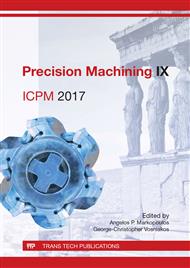[1]
K. Cheng, Machining dynamics—fundamentals. Applications and practices. Springer, (2009).
Google Scholar
[2]
A.M. El-Tamimi, T.M. El-Hossainy, Investigating the machinability of AISI 420 stainless steel using factorial design, Mater. Manuf. Process. 23 (2008) 419–426.
DOI: 10.1080/10426910801974838
Google Scholar
[3]
A.G. Mamalis, J. Kundrák, A. Markopoulos, D.E. Manolakos, On the finite element modelling of high speed hard turning, Int. J. Adv. Manuf. Technol. 38 (2008) 441-446.
DOI: 10.1007/s00170-007-1114-9
Google Scholar
[4]
U. Heisel, M. Storchak, D. Krivoruchko, Thermal effects in orthogonal cutting, Prod. Eng. Res. Devel. 7 (2013) 203–211.
DOI: 10.1007/s11740-013-0451-9
Google Scholar
[5]
T. Özel, E. Zeren, Finite element modeling the influence of edge roundness on the stress and temperature fields induced by high-speed machining, Int. J. Adv. Manuf. Technol. 35 (2007) 255-267.
DOI: 10.1007/s00170-006-0720-2
Google Scholar
[6]
E. Bagci, 3-D numerical analysis of orthogonal cutting process via mesh-free method, Int. J. Phys. Sci. 6 (2011) 1267-1282.
Google Scholar
[7]
J. Limido, C. Espinosa, M. Salaün, J.L. Lacome, SPH method applied to high speed cutting modeling, Int. J. Mech. Sci. 49 (2007) 898-908.
DOI: 10.1016/j.ijmecsci.2006.11.005
Google Scholar
[8]
U. Umer et al., Assessment of finite element and smoothed particles hydrodynamics methods for modeling serrated chip formation in hardened steel, Adv. Mech. Eng. 8(6) (2016): 1687814016652372.
DOI: 10.1177/1687814016652372
Google Scholar
[9]
U. Umer, J.A. Qudeiri, M. Ashfaq, A. Al-Ahmari, Chip morphology predictions while machining hardened tool steel using finite element and smoothed particles hydrodynamics methods, J. Zhejiang Univ-Sci A (Appl. Phys. & Eng. ) 17 (2016) 873-885.
DOI: 10.1631/jzus.a1600023
Google Scholar
[10]
J.O. Hallquist, LS-DYNA Theory Manual, Livermore Software Technology Corporation, California, (2006).
Google Scholar
[11]
C. Espinosa, J.L. Lacome, J. Limido, M. Salaün, C. Mabru, R. Chieragatti, Modelling High Speed Machining with the SPH Method, 10th International LS-DYNA Users Conference, (2008).
DOI: 10.1504/ijmmm.2011.039645
Google Scholar
[12]
G.R. Johnson and W.H. Cook, Fracture characteristics of three metals subjected to various strains, strain rates, temperatures and pressures, Eng. Fract. Mech. 21 (1985) 31-48.
DOI: 10.1016/0013-7944(85)90052-9
Google Scholar
[13]
Y. Huang, S.Y. Liang, Cutting forces modeling considering the effect of tool thermal property—application to CBN hard turning, Int. J. Mach. Tool Manu. 43 (2003) 307–315.
DOI: 10.1016/s0890-6955(02)00185-2
Google Scholar
[14]
P. Sartkulvanich, F. Koppka, T. Altan, Determination of flow stress for metal cutting simulation—a progress report, J. Mater. Process. Tech. 146 (2004) 61–71.
DOI: 10.1016/s0924-0136(03)00845-8
Google Scholar
[15]
P.L.B. Oxley, Mechanics of Machining: An Analytical Approach to Assessing Machinability, Halsted Press, New York, (1989).
Google Scholar
[16]
C.Z. Duan, T. Dou, Y.J. Cai, Y.Y. Li, Finite Element Simulation and Experiment of Chip Formation Process during High Speed Machining of AISI 1045 Hardened Steel, Int. J. Recent Trends Eng. 1 (2009) 46-50.
Google Scholar
[17]
U. Heisel, W. Zaloga, D. Krivoruchko, M. Storchak, L. Goloborodko, Modelling of orthogonal cutting processes with the method of smoothed particle hydrodynamics, Prod. Eng. Res. Devel. 7 (2013) 639-645.
DOI: 10.1007/s11740-013-0484-0
Google Scholar
[18]
T. Özel, E. Zeren, Finite Element Method Simulation of Machining of AISI 1045 Steel With A Round Edge Cutting Tool, Proceedings of the 8th CIRP International Workshop on Modeling of Machining Operations, May 10-11, 2005, Chemnitz, Germany.
Google Scholar


